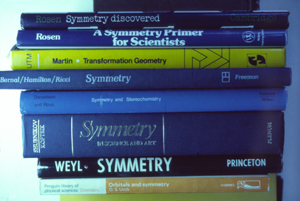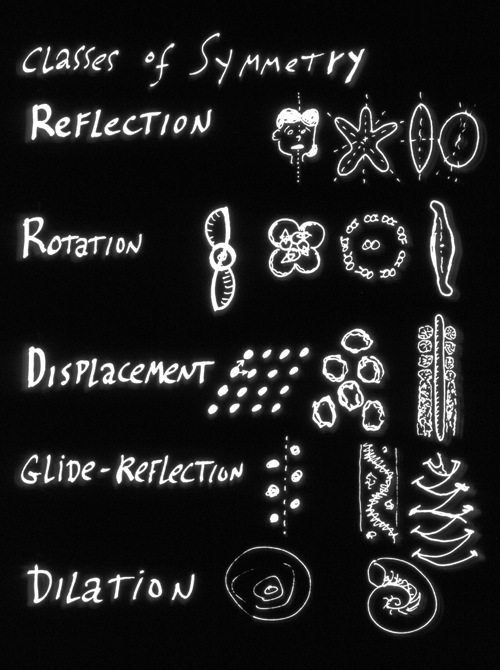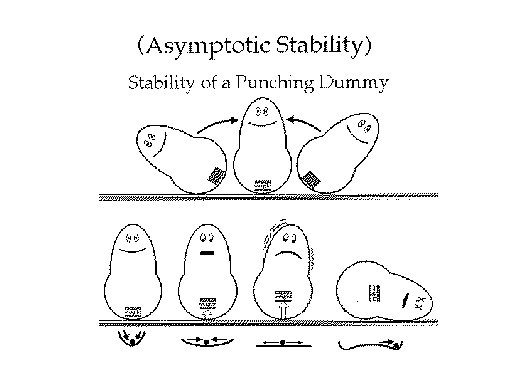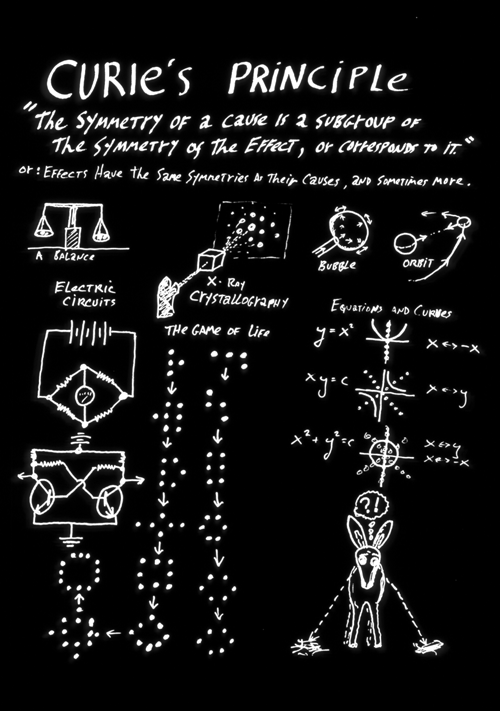Embryology Biology 441 Spring 2010 Albert Harris
Symmetry
A brief but necessary digression about the concept of symmetry, and "symmetry breaking".
What key ideas about symmetry do you need?#1) There are more kinds of symmetry than reflection symmetry.
Displacement symmetry (somites, for example; and ions in crystals; Many examples in two and three dimensions; stripes & dots on animals.
Dilation symmetry (magnification or shrinkage)
Remember Driesch? Remember slime-mold slugs & fruiting bodies?
Rotation symmetry (propellers, snail shells)
Combinations can occur between two or more kinds of symmetry:
...between rotational and dilation symmetry in snail shells: Magnify by 50 % equivalent to rotation by some number of degrees
...between reflection and displacement in "glide reflection" symmetry.
Given a letter of the alphabet, or a drawn shape, can you state which kinds of symmetry it has, or which combinations? A, B etc N, S etc. H, I, 8 etc. * etc.
#2) Weyl's way of defining symmetries:
"ÉIf there is something you can do to it, and it looks the same.. (reflect it, displace it, rotate itÉdistort itÉanything that leaves it looking the same, then the thing has reflection symmetry, displacement symmetry, rotational symmetry)
Notice this allows you to invent/discover your own new kinds of symmetry, that are useful for comprehending how embryos create shapes.
Most (all?) embryological shape changes are reductions in some symmetry.
Somite formation reduces from infinite displacement symmetry to displacement symmetry by just certain amounts. Likewise, consider a spherical embryo loosing infinity minus one planes of reflection symmetry.
(Is it helpful to consider conjoined twins as having lost infinity minus two planes of reflection symmetry?)
#3) Not just objects have particular symmetries, so do forces and processes.
In the clock & wave-front theories of somite formation, a time-displacement symmetry produces a reduced space-displacement symmetry (somites)
If the forces causing a shape have spherical symmetry (the same strength in all directions), then what shape will these forces create?
In order to make a less symmetrical shape, what property has to change?
#4) Curie's Law, and embryological mechanisms that evade this law.
Effects can't have less symmetry than their causes. (no problem gaining symmetry)
For example, can spherically symmetrical forces produce square shapes? What shapes can they produce.
If a crystal structure has inversion symmetry with respect to electrical charges, can it be piezoelectric? No, it can't. And the converse is also true! Piezoelectric properties are caused by NOT having inversion symmetry of charge.
This is how Curie, a co-discoverer of piezoelectric effects, got interested in how to relate phenomena to symmetries, maybe a bigger discovery than co-discovering radium!
Oh, yeah? Let's see somebody destroy a city with symmetry? ...besides Le Corbusier!
#5) How to evade Curie's Law (become less symmetrical, but not randomly) is THE central problem of developmental biology.
This opinion is shared by nearly all biologists who collect books on symmetry, which is hardly any.

What methods do embryos use to make themselves less symmetrical, but without becoming random?
This is a central question of Embryology;
arguably THE central question,
when you learn all the different kinds of symmetry,
but very few embryologists understand enough math & physics to know it.
How to develop the same asymmetries every time, such as the right/left asymmetry?
___________________________________________________________
Why are oocytes and early embryos spherical?
(in most kinds of animals, although NOT flies)
It's because their shapes are caused by counterbalances of highly symmetrical forces.
The outward fluid pressure inside an oocyte, has equal strength in all directions (= is spherically symmetrical).
The contractile and elastic tension in its surface also have equal strength in all directions (parallel to this surface)
Symmetrical forces create shapes with the same symmetries as the forces
Most people are not used to thinking of forces as having symmetries,
but they do. Even algebraic equations and laws of nature have symmetries.
The conservation of energy, momentum, electric charge, angular momentum etc.
each result from particular symmetries in laws of physics. (don't worry about this)
For us, the important fact is that to create a less symmetrical shape, some of the forces would have to be stronger in some particular direction.
(in other words, some force would have to be less symmetrical
then the shape of the embryo can also become less symmetrical, and have the same reduced symmetry as the force that causes this change.)
When anything becomes less symmetrical, that is called "symmetry breaking", although it doesn't necessarily mean anything is breaking, just that something is becoming less symmetrical than it had been until then.
________________________________________________________________
Example:
Visualize an ordinary dinner plate and a drinking glass;
they both have axial symmetry.
Their geometry is symmetrical about a vertical axis:
the same in all sideways directions from a vertical axis through their center.
They don't have the same shape; but they do have the same symmetry.
If you drop a glass or a plate on a hard surface, it probably will break into many asymmetrical pieces.
That is a crude example of symmetry breaking, and not difficult.
Much more difficult would be to break a glass or a plate so that it broke into two symmetrical halves;
and even more difficult would be to break them consistently into slightly different right and left halves.
Embryos manage to break symmetry with consistent results. ___________________________________________________________________________________
First concept: How to define symmetry?
Consider the capital letter A.
If we reflect an A in a mirror, it looks (almost the same).
It has a vertical plane of "Reflection Symmetry"
The letters B, C, D and E all have horizontal planes of reflection symmetry.
? What other letters have planes of reflection symmetry (I count a total of 17)?
(but you might not agree with me about L having a diagonal plane of reflection symmetry)
What about the letter H?
H has a vertical plane of reflection symmetry,
and also has a horizontal plane of reflection symmetry.
(two, non-equivalent planes of reflection symmetry
The letter "I" also has two perpendicular planes of reflection symmetry.
What symmetries do the numbers 8 and 0 have?
What about the symbols * , + , - , ^ ,<, > and %?
A circle O has an infinite number of planes of reflection symmetry,
all of which are equivalent to each other.
(Notice the contrast with H, 8 and 0, and squares,
all of which have non-equivalent planes of symmetry.
A square has four planes of reflection symmetry, 2 of one kind & 2 of another)
Most embryos start out with an infinite number of planes of symmetry, like a cone, or a hemisphere, dinner plate or water glass. ("axial symmetry") And then special mechanisms reduce = "break" symmetry.
Mammal oocytes come close to having spherical symmetry, but for most kinds of animals, the yolk is more concentrated near the vegetal pole from the very beginning, so they never have more than axial symmetry.
Formation of the grey crescent breaks axial symmetry and replaces it with one plane of reflection symmetry.
This amounts to the destruction of infinity-minus-one planes of reflection symmetry.
Second big concept: There are more kinds of symmetry than just reflection.
Please consider the symmetry of the letters S, N and Z.
They all have two-fold rotational symmetry.
A three-bladed propeller has 3-fold rotational symmetry.
A swastika has 4-fold rotational symmetry, etc.
The internal microtubule structures of cilia and flagella have 9-fold rotational symmetry, but do not have reflection symmetry.
Vertebrate embryos use this lack of reflection symmetry to control creation of Right-Left differences, (very much like the "Right Hand Rule" in the physics of electromagnetism.)
Mutants (including mutant humans) who lack beating flagella nevertheless develop right-left asymmetry
more kinds of symmetry
Consider the symmetry of the following pattern @@@@@@@@@@@
This has displacement symmetry.
A line _______________________________________
can be said to have infinite displacement symmetry, in that it it looks the same for any (small or big) amount of displacement. but this line -------------------- only has displacement symmetry for displacements of a certain distance. (a sine wave is another example). When an embryo becomes segmented, & when it forms somites, Then it is "breaking" displacement symmetry.
QUESTION FOR CLASS DISCUSSION:
Turing's reaction-diffusion mechanism serves to break what kind of symmetry?
Even more kinds of symmetry
Another kind of symmetry is dilation symmetry.
(When something continues to look the same when magnified)
Snail shells have combined rotation and dilation symmetry;
Certain amounts of rotation produce the same apparent change
As certain amounts of magnification.

Certain phenomena look the same at different size scales.
Mathematicians and engineers say that these phenomena "scale"
I recently bought an applied physics book titled "Scaling", which is about variations in the extent to which physical phenomena (explosions, for example) produce the same shapes ("mushroom-shaped clouds" for example) over wide ranges in sizes.
Self-Symmetry of Fractals is also amusing. (but please don't let yourself get carried away with fractals & chaos theory; neither is a hundredth as important as the principles of symmetry).
You can invent new kinds of symmetry, such as reflection in a distorting mirror
A Third big concept, related to symmetry
Stability different kinds of stability
Divergence away from a stable state: Can break symmetry.
Is achieved either by positive feed-back, or loss of negative feedback
Convergence toward a stable state (can create shape, & create symmetry)
Is best achieved by negative feed-back, homeostasis

